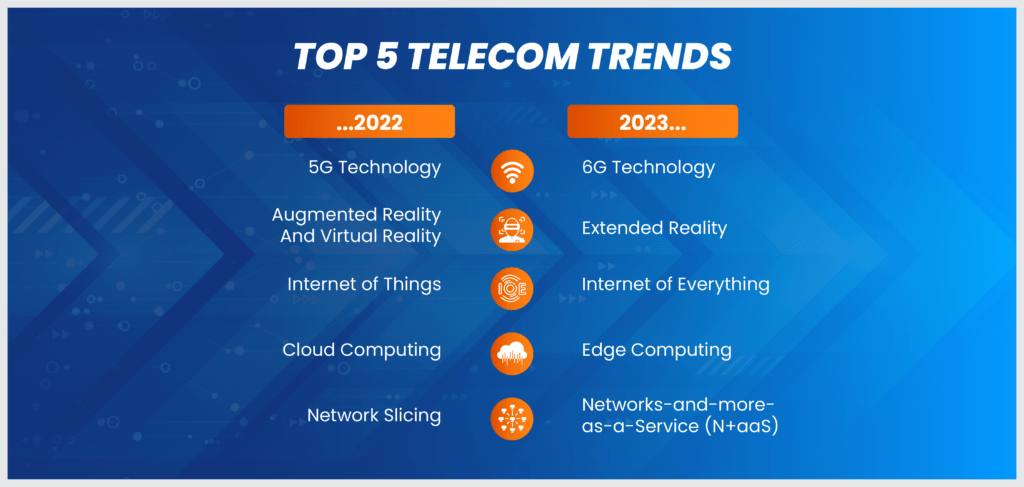Bringing the “New” to Telecom this year
The telecom sector has made remarkable advancements in elevating the digitization journey driven by business optimization through operations. The industry has an unprecedented scale of growth by expanding its collaboration allowing high-speed networks to become more accessible. While Edge Computing and Augmented Reality have the limelight as telecom trends, these tools are expected to become more mainstream integrating themselves into every service and making the user experience of applications skyrocket.
With the increase in the number of consumers, CSPs are now channelizing their networks to generate a better ROI in the coming years. The growth of industry analytics for service providers like KPIs has allowed telecom operators to analyze their data, building a more sustainable platform for their business and network operations.
Improving customer service and stepping away from off-the-shelf products are allowing companies to score customer service by promising more personalized services. This is creating a larger impact on revenue allowing diversification in services in the coming years and will always be a key telecom industry trend.
Operators are now providing invaluable services which are expected to become inseparable parts of various industries. The global telecom analytics market size was valued at USD 4.17 billion in 2022. It is projected to reach USD 13.76 billion by 2031, growing at a CAGR of 14.2% during the forecast period (2023–2031).
Telecom Industry Trends: Setting Innovation in Motion

1. 5G to 6G
6G will soon be boundlessly available by demand by users at the end of the 2030s. Being significantly faster than 5G, the performance of the improved technology will deploy many more devices to become an omnipresent channel for users.
While 5G has sent shock waves with its speed compared to 4G/LTE networks, 6G is expected to be at least 100 times faster with the added advantage of the reliability and network range. This will have a domino effect, accelerating the use of other solutions like IoT platforms for telecom. In the coming years, research will set up a better architecture for the upcoming network enabling operators to provide better services. Connecting more devices per square meter, 6G will make connectivity between the real world and experiences smarter and it will be one of the top telecom trends in 2023.
Cyber-physical continuum will begin to exist with the aid of CSPs to provide a link going further than just communication. Experience is the new product and 6G will make it possible in the coming years allowing the two worlds to coexist. Enhancing the transmission of large data around the world, 6G will enable distinctive technologies to amalgamate to stay on top of the telecom trends list. It will allow high-performance computing for a centralized resource for data processing.
2. AR/VR to XR
Extended reality (XR) is the parasol of technologies like Augmented Reality and Virtual Reality. XR has created experiences never seen before powered by high-speed networks backing them up. From marketing campaigns to business strategies, XR has created an immersive experience creating a laborious competition.
Telcos have been playing a more prominent role in proving XR to be a powerful tool for collaboration and communication globally and thus it is one of the widely accepted telecom trends. Painting a clear picture of the benefit of this technology, aspects of every industry are covered by this tool. Moving from AR/VR has been seamless giving consumers a more alluring experience. CSPs can improve market products bridging the gap previously left behind by other technologies and ushering consumers to their products by taking advantage of this one of the definitive telecom trends.
3. IoT to the Internet of Everything (IoE)
The Internet of everything is slowly taking over its predecessor and can’t be struck out from the telecom trends list. Unlike IoT, the Internet of Everything (IoE) is the macroscale looking deeper into the initial vision. The new and improved version which will slowly take over the industry is looking at the edge over the cloud while focusing on decentralization and delegation. While IoT focuses on the connection of devices, the coming years are creating a demand for a more impactful technology that seeks to provide capabilities much more than that.
The Internet of Everything will leverage data generated by numerous devices to offer a border view of processes that generate critical insight for businesses. Being the next progressive stage, this technology is the outbound third platform that is widely distributed and hyper-connected creating the understructure which is hyper-connected to enable easier network communication that makes it an essential tool for operators along with being one of the top telecom industry trends.
The Internet of Everything offers a more decentralized processing system where the data process is distributed unlike before through a single system. This plays a key role in the data input and output. In the coming years and beyond, demand for data exchange has emerged making it important to collect data from various sources to further personalize services for end users. IoE works with other technologies like IoT, AI, Cloud, Edge, and more making sure that devices are interconnected to bring a complete digital transformation in the future. This is definitely one of the major telecom industry trends to look forward in 2023.
4. Cloud Computing to Edge Computing
Edge computing is taking over the industry by filling in the spaces left behind by lower latency across networks as a result of working with centralized computer systems. Data has become critical for businesses and the future’s reliance on it has increased multi-folds. This has been one of the leading telecom trends for many years.
A delay in this process can cause inefficient business strategies, therefore making edge computing a paramount transformation from cloud computing. In 2023 and forward performance requirements by 5G will improve user experience. Edge computing allows an organization for a smart device to measure its performance through decentralized processes against a set of tolerance levels to reveal undiscovered patterns.
Edge computing gives a contour in the coming years by providing a reduction in delayed time and a faster decision-making process. This helps operators to reduce costs, prevent loss and create a place for themselves in the market. Grand View Research estimates the global edge computing market will expand at a CAGR of 38.9% from 2022 to 2030. Precedence Research has estimated the global edge computing market will reach $51.2 billion in 2023 and surpass $116.5 billion by 2030. This is one of the telecom industry trends to look forward to in 2023.
5. Network Slicing to Networks-and-more-as-a-Service (N+aaS)
The new in the telecom industry trends list is NaaS, a malleable infrastructure that helps businesses to keep up with the dynamic environment of innovation that enables it to meet the latest business requirements which creates an effective performance by its networks. Organizations have optimized traditional services like network slicing to a more cloud-like model.
NaaS offers a one-time package that allows enterprises to customize their hardware, software, and consumption. Operators are moving to more personalized service buying. Off-the-shelf packages offered before NaaS are being upgraded to technologies that tailor fit the businesses in particular. This is one of the telecom industry trends considered by industry experts.
Network slicing impacts resource sharing along the built network across domains of management. 2023 is going to see a boom in NaaS as it allows individual functions to be outsourced like software and monitoring that decompresses the end-to-end system. This allows businesses to lessen the weight of single functions. Thus, it will prove to be one of the most significant telecom industry trends in 2023.
Continuing the Value Chain Momentum for Future Growth
The major focus of the coming years is to transition into new technologies seamlessly bringing innovation to the forefront to transform business processes. Exciting possibilities are on their way to creating a new generation of building innovative network technologies.
Hyper-connected gold will bring a new dimension to the virtual world providing wider opportunities. Having an integrated one-shop stop is a challenge faced by businesses capable of handling strategic initiatives. The impact of this is dependent on the market maturity and 2023 is here to solve operation roadblocks by providing remarkable solutions.
6D Technologies focuses on these telecom trends and future-ready technologies to seamlessly integrate various technological needs by providing a single solution for multiple problems. Interviewing the existing network architecture to provide a self-sufficient system from the existing one can reduce costs and increase overall paybacks. Showing light in the current dynamic environment, CSPs are turning to sustainable and trusted providers that prioritize success while yielding a competitive edge.
The telecom space is moving towards a better tomorrow in 2023, is your sphere ready? Are you leveraging the advantage of the top telecom trends?
Contributing Author – Neha is a marketing strategist with 15+ years of experience, who manages the entire digital marketing gamut. She’s adept in marketing planning and execution and uses her thought leadership for strategic utilization and deployment of available resources to achieve organizational objectives. She works and mentors her team for all Inbound marketing activities, with complete flexibility. Neha is a nomadic traveller who loves exploring new places and connecting with people and enjoys reading travel articles and fiction. Connect with her on LinkedIn.




